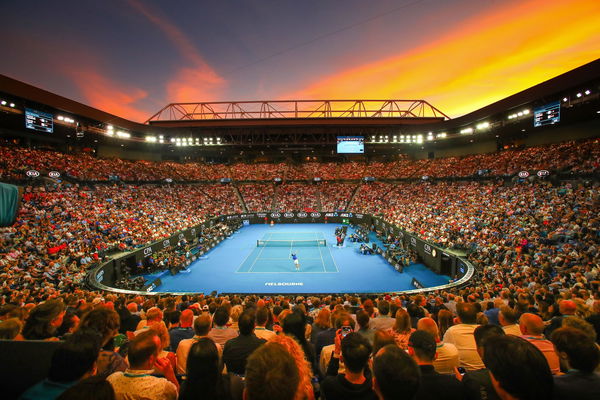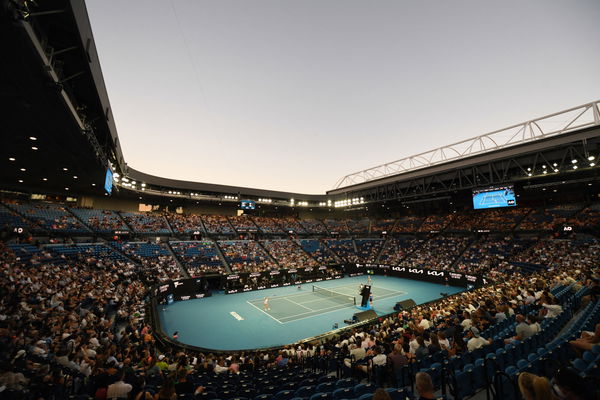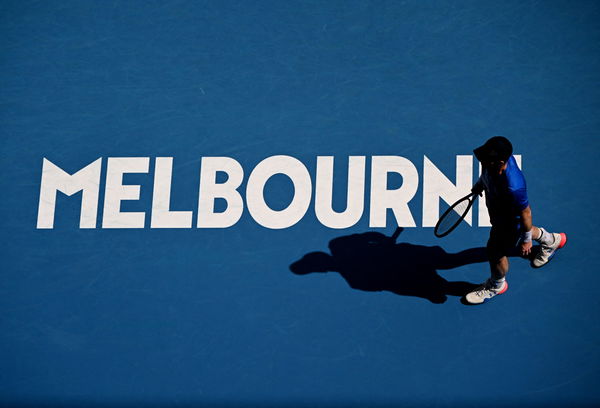
Getty
A general view inside Rod Laver Arena at sunset during the Men’s Singles Final match betwen Novak Djokovic of Serbia and Rafael Nadal of Spain during day 14 of the 2019 Australian Open at Melbourne Park on in Melbourne, Australia. (Photo by Scott Barbour/Getty Images)

Getty
A general view inside Rod Laver Arena at sunset during the Men’s Singles Final match betwen Novak Djokovic of Serbia and Rafael Nadal of Spain during day 14 of the 2019 Australian Open at Melbourne Park on in Melbourne, Australia. (Photo by Scott Barbour/Getty Images)
The heat is on and so will be the first Grand Slam of the season in just 5 days. Several superstars of the game have already started to land at the Tullamarine Airport. But what’s more concerning for everyone in Australia is Melbourne’s baking temperatures.
Watch What’s Trending Now!
Australians have faced severe natural disasters in the last year with several bushfires, the Sunbury earthquake, and Cyclone Ilsa. But nothing comes close to the heat, often known as Australia’s ‘silent killer’. Let’s discuss how the scorching weather conditions get during the Australian Open and what their heat policies are all about.
ADVERTISEMENT
Article continues below this ad
How scorching does it get at the Australian Open?
The Australian Open takes place during the month of January every year. During that time when a majority of the world enjoys snowfalls, this part of the planet faces extreme temperatures which can go up to 45 degrees Celsius. Tennis is a sport that demands repetitive short and high-intensity sprints throughout a game. To do that in such playing conditions is next to impossible. Especially for those who come from European nations, who find it extremely hard to adapt to the heat. Hence, a lot of health-related illness is often seen gripping those on the hard courts.

Reuters
Tennis – Australian Open – Melbourne Park, Melbourne, Australia – January 21, 2022 General view of Australia’s Ashleigh Barty and Italy’s Camila Giorgi in action during their third round match REUTERS/Morgan Sette
The Rod Laver Arena was introduced nearly about 36 years ago. It enabled the players to compete under the roof if the temperature hit 40 degrees Celsius. Then in 1998, it was announced that if the temperature reached the 40 degrees Celsius mark- the matches across all the courts would be halted. The mark was later changed during the 2002 and 2003 seasons.
ADVERTISEMENT
Article continues below this ad
By 2014, the temperatures hit a staggering 43.9 degrees Celsius and as a result, the play had to be stopped on several occasions. A few players faced health-related illnesses and 9 players even had to retire during their opening matches.
Although the normal temperature for the middle of January in Australia is 26 degrees Celsius, the past few years have seen it reach between 30-40 degrees Celsius. In 2015, the temperature hit 40 degrees Celsius. To counter all these issues and to improve the playing conditions, the organizers came up with an Extreme Heat Policy in 2019.
ADVERTISEMENT
Article continues below this ad
The Extreme Heat Policy at the Australian Open
The 2019 Australian Open witnessed a more extensive heat policy. It was introduced after several tests and research conducted jointly by the Thermal Ergonomics Laboratory at the University of Sydney and Tennis Australia’s medical personnel. The objective of all these tests was to know the specific effects of heat stress on the players.

Reuters
Tennis – Australian Open – Melbourne Park, Melbourne, Australia – January 19, 2022 General view of fans in Melbourne Park REUTERS/Loren Elliott
The Australian Open Extreme Heat Protocol (AO-EHP) was introduced to provide consistent and fair playing conditions to all the players. A screen with a semi-circle of five colors with a reading from 1 to 5 is put on display during every match day. It’s the Australian Open Heat Stress Scale (AO-HSS).
A deeper dive into the 2024 Australian Open policy
To continue the high-intensity games throughout the event under scorching heat the AO organisers came up with a Heat Stress Scale 5 years ago. It is basically a guideline that needs to be followed whenever there is a temperature rise. Here’s a more detailed analysis straight from the official Australian Open website on the scale.
It says, “The Heat Stress Scale will be used to measure four climate factors – radiant heat (strength of the sun), air temperature in the shade, relative humidity and wind speed. These will be measured at five positions around the precinct, including on court in Rod Laver Arena, Margaret Court Arena and Melbourne Arena. The scale starts at (1) for temperate playing conditions and escalates to (5) – suspension of play.”

Reuters
Tennis – Australian Open – Melbourne Park, Melbourne, Australia – January 18, 2022 Britain’s Andy Murray during his first round match against Georgia’s Nikoloz Basilashvili REUTERS/James Gourley
Under the EHP rule, “The Tournament Referee will allow a 10-minute break between the second and third sets in both women’s and junior singles matches and a 15-minute break in wheelchair singles matches when a four (4.0) is recorded on the AO HSS prior to or during the first two sets of the match.”
And, in the case of men’s singles, it says, “a 10-minute break will be allowed after the third set when a four (4.0) is recorded on the AO HSS prior to or during the first three sets of the match. If a five (5.0) is recorded on the AO HSS. The Tournament Referee can suspend the start of matches on outdoor courts. And, all matches in progress continuing until the end of an even number of games in that set or completion of the tie break before play will be suspended.”
READ MORE – All You Need to Know About the Australian Open 2021 Retractable Roof
Furthermore, “Matches on Rod Laver Arena, Margaret Court Arena and Melbourne Arena will stop after an even number of games in that set or completion of the tie-break when the Tournament Referee can decide to close the roof for the remainder of the match and the following matches when the EHP is still in effect.”
Can we guess what kind of weather Melbourne will see this year based on what it was like last year?
How hot was the 2023 Australian Open?
Without a doubt, every player wants to be a part of this 119-year-old prestigious tournament. However, the harsh weather conditions make it more challenging for them to keep up their stamina throughout the game. In 2023, the play got suspended on day 2 due to extreme heat. The Australian Open heat policy was seen in action last year when the scale reached the 5 mark. With temperatures over 35 degrees Celsius, players had to wait inside their changing room for almost 3 hours. What will happen this time?

Getty
An Australian Open flag is seen with the city shrouded in smoke in the background ahead of the 2020 Australian Open at Melbourne Park on January 14, 2020 in Melbourne, Australia. (Photo by Graham Denholm/Getty Images)
Well, as per the latest weather forecast, the 2024 Australian Open could witness light to heavy rainfall during the first three days of the event. Then from January 17, it looks all good to put on a show which all the tennis fans from all over the world must be waiting for. The weather is predicted to be around 15-31 degrees Celsius. And, if stays like this would surely be a pleasant condition for all the players as well as the spectators on the ground.
Watch This Story: Venus And Serena Williams Tease A Tennis Feast For Fans In A Promising Yet Unknown Collaboration
ADVERTISEMENT
ADVERTISEMENT
ADVERTISEMENT
ADVERTISEMENT



